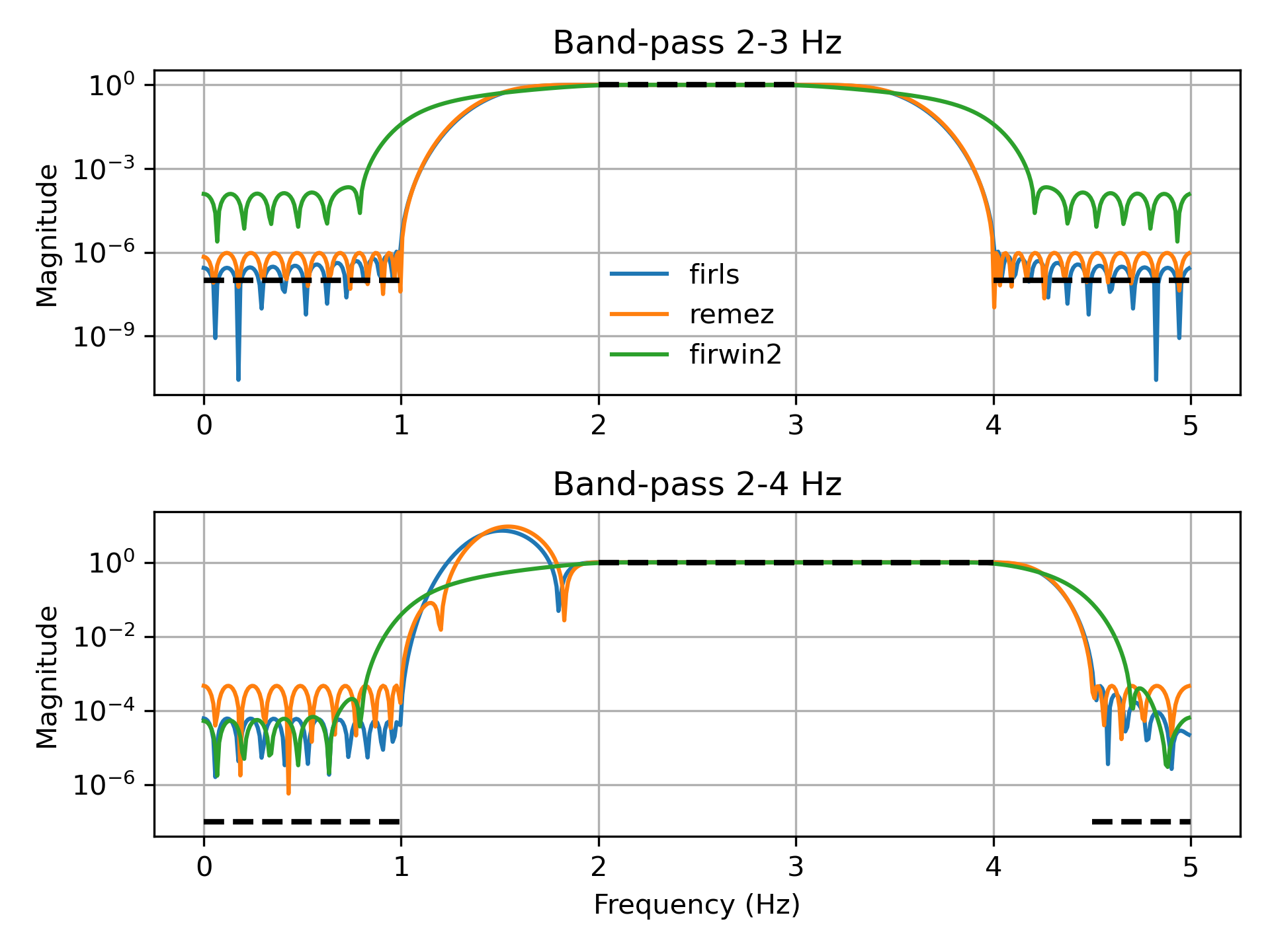firls(numtaps, bands, desired, weight=None, nyq=None, fs=None)
Calculate the filter coefficients for the linear-phase finite impulse response (FIR) filter which has the best approximation to the desired frequency response described by bands
and :None:None:`desired` in the least squares sense (i.e., the integral of the weighted mean-squared error within the specified bands is minimized).
This implementation follows the algorithm given in . As noted there, least squares design has multiple advantages:
Optimal in a least-squares sense.
Simple, non-iterative method.
The general solution can obtained by solving a linear system of equations.
Allows the use of a frequency dependent weighting function.
This function constructs a Type I linear phase FIR filter, which contains an odd number of :None:None:`coeffs` satisfying for $n < numtaps$
:
The odd number of coefficients and filter symmetry avoid boundary conditions that could otherwise occur at the Nyquist and 0 frequencies (e.g., for Type II, III, or IV variants).
The number of taps in the FIR filter. :None:None:`numtaps` must be odd.
A monotonic nondecreasing sequence containing the band edges in Hz. All elements must be non-negative and less than or equal to the Nyquist frequency given by :None:None:`nyq`.
A sequence the same size as bands
containing the desired gain at the start and end point of each band.
A relative weighting to give to each band region when solving the least squares problem. :None:None:`weight` has to be half the size of bands
.
Deprecated. Use `fs` instead. Nyquist frequency. Each frequency in bands
must be between 0 and :None:None:`nyq` (inclusive). Default is 1.
The sampling frequency of the signal. Each frequency in bands
must be between 0 and fs/2
(inclusive). Default is 2.
Coefficients of the optimal (in a least squares sense) FIR filter.
FIR filter design using least-squares error minimization.
We want to construct a band-pass filter. Note that the behavior in the frequency ranges between our stop bands and pass bands is unspecified, and thus may overshoot depending on the parameters of our filter:
>>> from scipy import signal
... import matplotlib.pyplot as plt
... fig, axs = plt.subplots(2)
... fs = 10.0 # Hz
... desired = (0, 0, 1, 1, 0, 0)
... for bi, bands in enumerate(((0, 1, 2, 3, 4, 5), (0, 1, 2, 4, 4.5, 5))):
... fir_firls = signal.firls(73, bands, desired, fs=fs)
... fir_remez = signal.remez(73, bands, desired[::2], fs=fs)
... fir_firwin2 = signal.firwin2(73, bands, desired, fs=fs)
... hs = list()
... ax = axs[bi]
... for fir in (fir_firls, fir_remez, fir_firwin2):
... freq, response = signal.freqz(fir)
... hs.append(ax.semilogy(0.5*fs*freq/np.pi, np.abs(response))[0])
... for band, gains in zip(zip(bands[::2], bands[1::2]),
... zip(desired[::2], desired[1::2])):
... ax.semilogy(band, np.maximum(gains, 1e-7), 'k--', linewidth=2)
... if bi == 0:
... ax.legend(hs, ('firls', 'remez', 'firwin2'),
... loc='lower center', frameon=False)
... else:
... ax.set_xlabel('Frequency (Hz)')
... ax.grid(True)
... ax.set(title='Band-pass %d-%d Hz' % bands[2:4], ylabel='Magnitude') ...
>>> fig.tight_layout()
... plt.show()

The following pages refer to to this document either explicitly or contain code examples using this.
scipy.signal._fir_filter_design.firwin
scipy.signal._fir_filter_design.firwin2
scipy.signal._fir_filter_design.firls
scipy.signal._fir_filter_design.remez
Hover to see nodes names; edges to Self not shown, Caped at 50 nodes.
Using a canvas is more power efficient and can get hundred of nodes ; but does not allow hyperlinks; , arrows or text (beyond on hover)
SVG is more flexible but power hungry; and does not scale well to 50 + nodes.
All aboves nodes referred to, (or are referred from) current nodes; Edges from Self to other have been omitted (or all nodes would be connected to the central node "self" which is not useful). Nodes are colored by the library they belong to, and scaled with the number of references pointing them